Glowing paint: types and applications
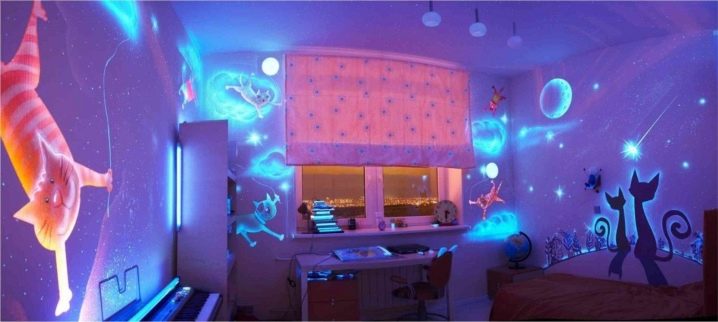
Manufacturers of paints and varnishes offered consumers a new solution for decoration and decoration of premises. The use of glowing paint in the interior will transform a dull and nondescript room. Ordinary objects will be filled with magic, will become an inspiration for fashionable ideas and ideas.
Peculiarities
On the shelves of specialty stores, you can find fluorescent paints that are able to accumulate daylight or artificial light (for example, from indoor lamps), and emit it at night, creating bright accents on painted surfaces. The service life can be very long. High cost effectiveness, the ability not to re-coat - all this increases demand and sales volumes increase. Phosphor is a pigment that accumulates and gives off light energy. It takes just 20 minutes of "recharge" for an eight hour glow. The shimmery powder is resistant to atmospheric changes, has permanent properties, which allows it to be used for all types of finishes. Depending on which varnish it is combined with, the area of application and the service life are determined.
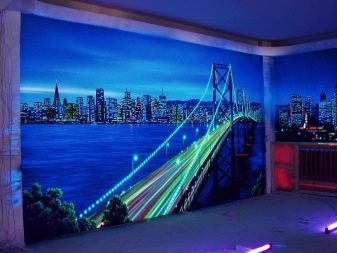
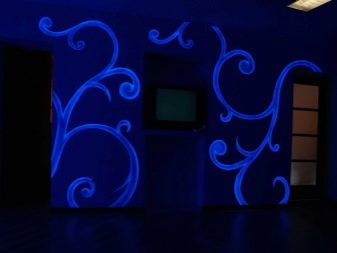
The duration and concentration of the glow depend on:
- the pigments used;
- illumination;
- time of light exposure;
- base coat colors.
With prolonged use, some species can be hazardous to health, since they contain toxic components. Fluorescent paints require special handling.
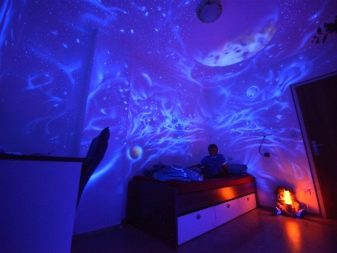
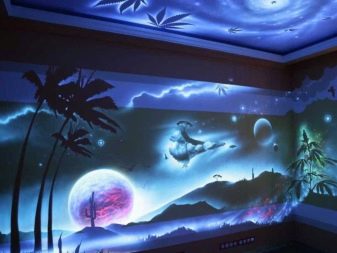
- Carry out work in a well-ventilated area;
- protective equipment is required: glasses, hats, gloves, masks;
- if vapors enter the respiratory tract, you need to urgently go to the hospital;
- contact with the eyes can lead to disastrous consequences. It is necessary to rinse them with plenty of water, and also consult a doctor immediately;
- if the paint is in the stomach, then the water will help remove it, cleanse the organs.
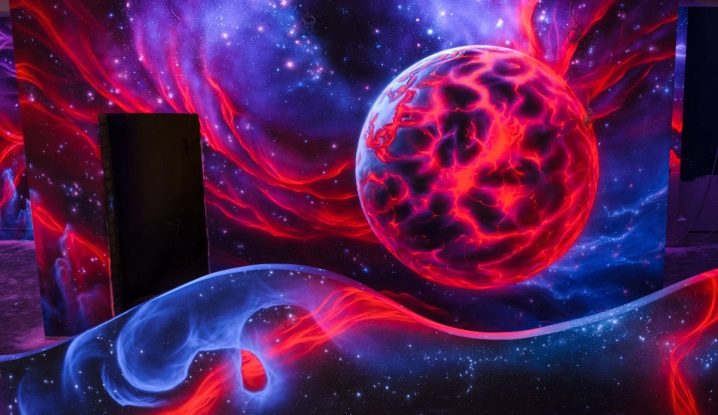
The high price is the main drawback of the material.
Views
There is no official classification of the product, but several varieties are distinguished by the type of active substance.
Fluorescent
The glow appears only under ultraviolet lamps. The effect disappears after turning them off. It is used in cafes and discos, and is also used for painting cars. Allows you to perform invisible paintings with a life story. Spray paint cans are ideal for painting cars, bicycles, motorcycles.
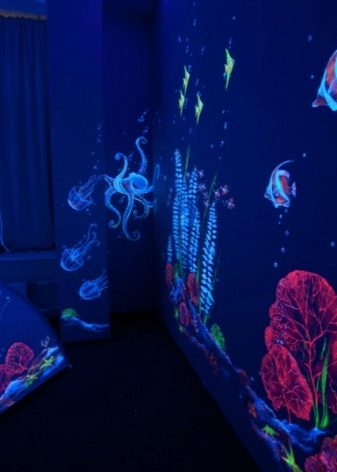
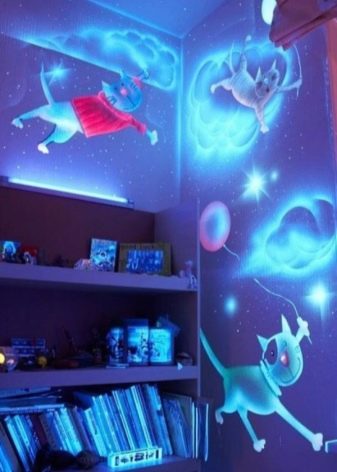
The polyacrylic and soda base paint does not pose a danger to human life. Used on items made of different materials. To work on a leveled and degreased surface, you will need a brush or roller. The most popular colors are green, yellow, red.
Luminescent
Ranks first in the sales ranking. Fifteen minutes of light accumulation is sufficient for colored objects to flicker throughout the night. Lights up for 12-18 hours, gradually fading out. Sunlight and UV lamps "charge" the paint the fastest. An alternative to a light charge is heat. A hot battery can become an extraordinary night light with an infinitely long and unique glow.

Alkyd polyurethane compounds - base. The absence of harmful substances makes it possible to use the solution for finishing the interior surfaces of apartments, furniture, in landscape design, in floristry, to use it for theatrical make-up, painting costumes and decorations.Improving safety at production and construction sites, reducing road accidents are the absolute advantages of introducing luminescent paint in various spheres of life. During operation, it is afraid of moisture.
Fluorescent fluorescent
It has two types of glow due to its versatile composition. Used in the exterior. For the street, a heat-resistant, friction-resistant, temperature-resistant and aggressive variety is recommended. Metal paint will protect against corrosion. Stained glass paints create a glossy film, do not require firing, and do not turn white after drying.

Phosphorescent
Popular phosphorus based paint glows in the dark. It has a negative effect on the body. Increasing the dose will lead to intoxication, nausea, weakness, dizziness. Prolonged contact with the substance affects the functioning of the heart, lungs, and can cause death. Applicable only for outdoor work. Its advantage is that it accumulates light in 10 minutes. For the decoration of stained-glass windows, glass, ceramic tiles, phosphorizing paint is used - a source of inspiration for a creative person.
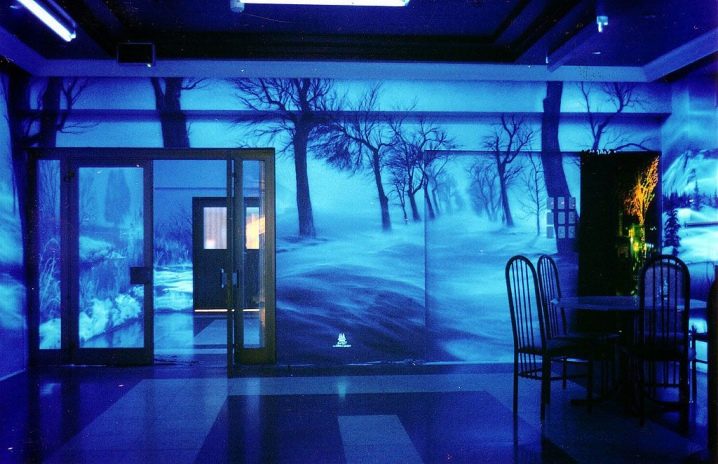
Composition
The technology of creation allows the use of both artificial and natural materials as a basis. The nonthermal glow of substances is called "luminescence".
The types of luminescence and the substances due to which it arises are as follows:
- fluorescence: quinine, rhodamines, eosin, acridine dyes;
- phosphorescence: zinc sulfide, strontium aluminate;
- chemiluminescence: oxidation of white phosphorus;

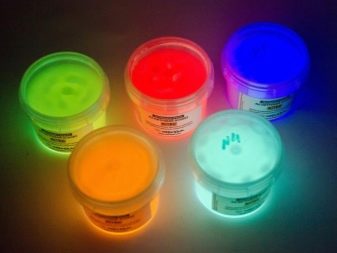
- bioluminescence: a chemical reaction in some organisms that allows them to glow from within
- radioluminescence: radiation from radioactive substances;
- electroluminescence: a phenomenon generated by an electric field.

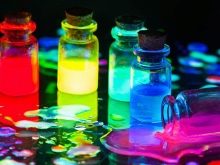
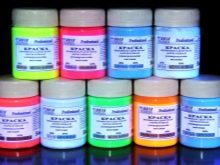
There are two types of phosphors:
- Live origin. This includes secondary naphtholic acid, a feature of which is the ability to create short-term outbreaks;
- Inorganic origin. This type includes compositions of phosphorus crystals with a constant glow effect.
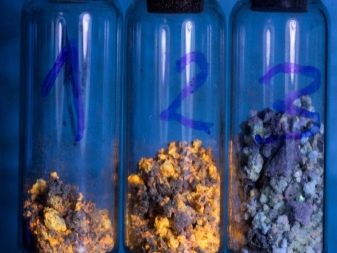
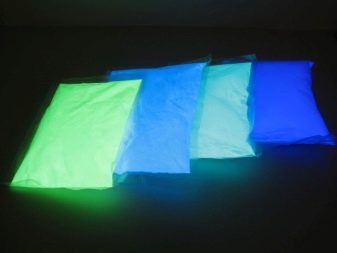
The paint contains concentrated and matte dye:
- Water based. Inexpensive, without a fetid odor, does not wash off in the process of precipitation.
- Alkyd based. Resistant to mechanical stress, cleaning agents, during operation emits toxic fumes.
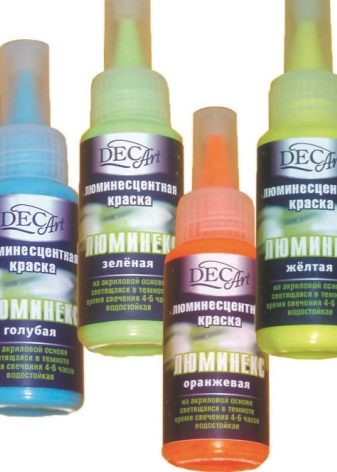
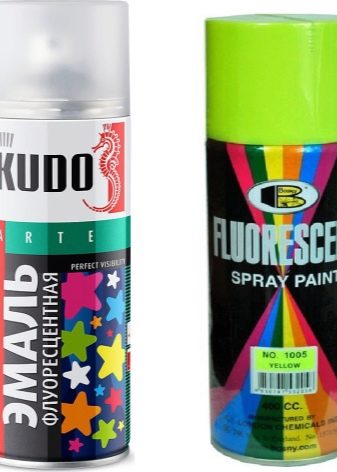
The composition of the dye also affects the operation:
- High adhesion paints are suitable for plastics;
- water-based - harmless and quick-drying options;
- heat-resistant ones are suitable for hot glass, metal, since they can withstand temperatures of 400 degrees;
- sealed create a moisture-repellent shell on bathtubs, swimming pools.
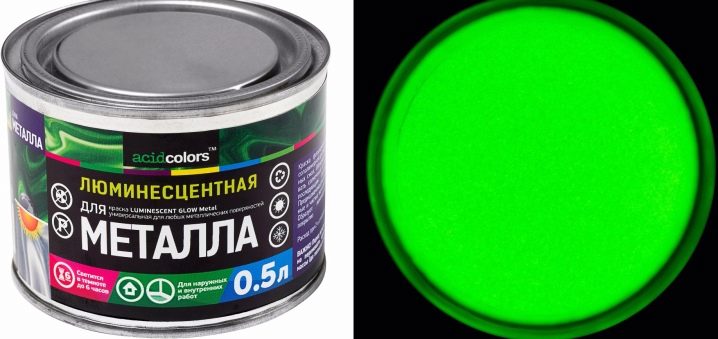
Colors
There are two degrees of transparency:
- transparent (colorless) - paint with a blue or green tint, invisible during the day;
- the color variety does not differ from ordinary paint in daylight, and emits a glow at night. Has different shades.
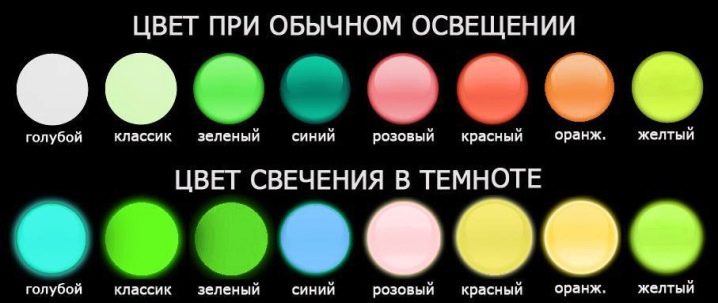
Fluorescent paint can have a variety of rich shades:
- citric;
- yellow;
- purple;
- mustard;
- Red;
- Brown.
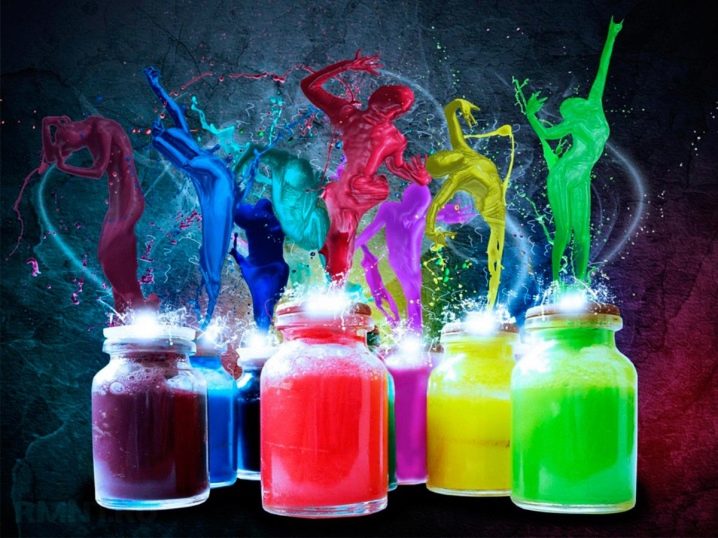
Black and white matte paints do not shine in ultraviolet rays, but they allow you to create shadows in drawings.
Luminescent coatings can be:
- green;
- orange;
- blue;
- yellow.

Application
An innovative technology for the production of luminous paint, its properties and colors - all this brings bright accents to a person's life.
It is used for the following purposes:
- for artistic painting of walls, ceilings of entertainment centers and recreation areas for young people. Surfaces can be made of dense and porous materials (brick, concrete, wallpaper);
- improving the appearance of nondescript furniture, paintings, interior items;
- creation of glowing make-up for the body and face, production of nail polishes;
- decoration of natural and artificial flowers and other floristic elements;
- coloring of theatrical outfits, costumes, accessories;
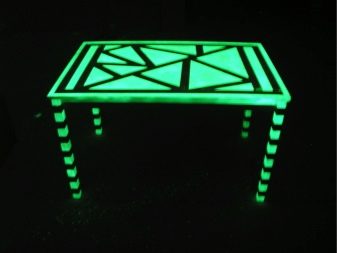

- blotches in advertising stickers, notebooks, posters;
- spectacular drawings on the body, caps, helmets, frames will emphasize the individuality of the motorist, and also form a glossy shell on the metal that is resistant to the action of oils, detergents, solvents;
- increasing the level of safety on the roads and in dangerous technical areas;
- street (front) decoration of houses, old premises;
- decor for glass, porcelain, ceramics (vases, glasses, glasses, ashtrays);
- production of luminous mechanisms for deep and night fishing, baits (jig, spoon) and other devices for fishing;
- design of collars for cats and dogs.
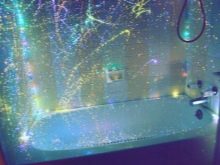

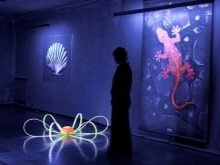
How to choose?
When choosing this original element for repair, you need to understand the difference between luminescent and phosphoric paint. The first one is absolutely harmless, suitable for a bedroom. The second contains life-threatening phosphorus. It is only suitable for outdoor work. Branded product is high quality, neatly applied, guarantees a uniform glow, makes it possible to choose the desired shade, is more durable, but has a high price.
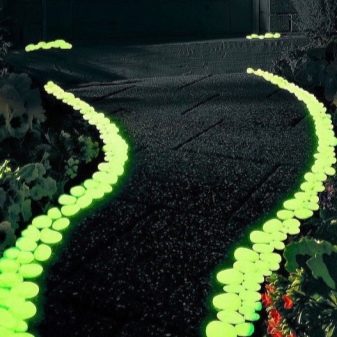
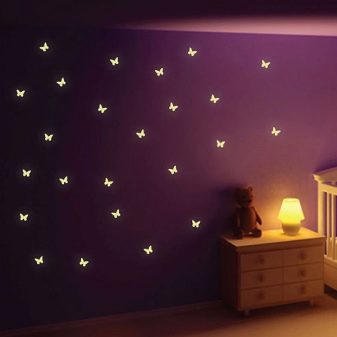
Possessing the initial basics of chemistry and knowledge of reagents, home craftsmen can prepare a phosphor on their own. Meticulous and creative work will allow you to reduce the estimate, carry out minor transformations. The basis of the artisanal phosphor solution is pine needles extract. The brightness of the glow depends on the volume of the concentrate
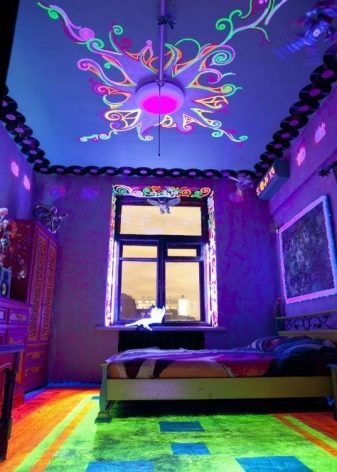
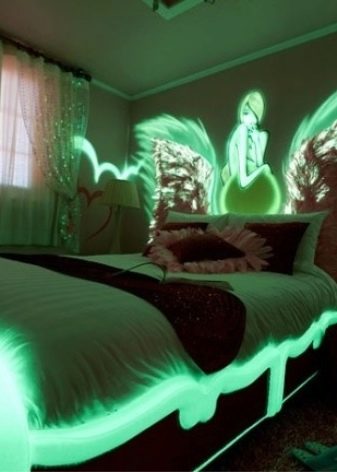
A universal set of pigments of famous brands is an indispensable assistant in creating neon paint at home, which has positive features:
- does not cause allergic reactions;
- does not collapse at high and low temperatures;
- long warranty period.
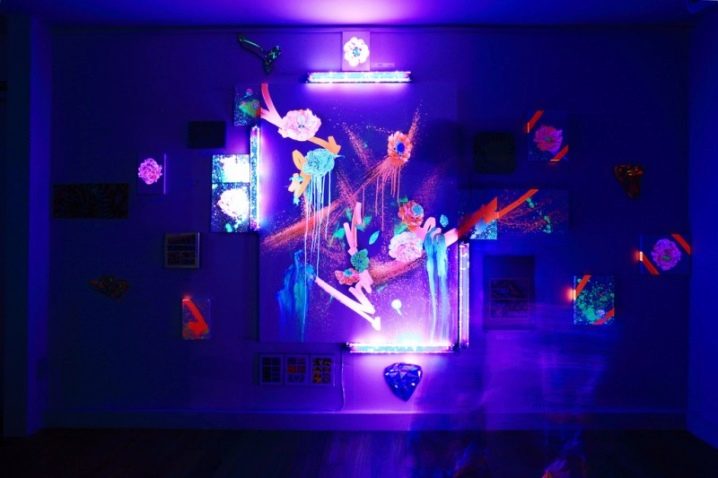
It is worth keeping in mind some of the nuances if you decide to organize a laboratory at home:
- white phosphorus and its derivatives do not glow without oxygen;
- a number of substances require friction and shaking;
- all substances must be stored separately;
- the reaction of the acid with sulfide forms hydrogen sulfide, which blocks the centers of smell, and when it gets on the hair and nail plates, the paint destroys them;
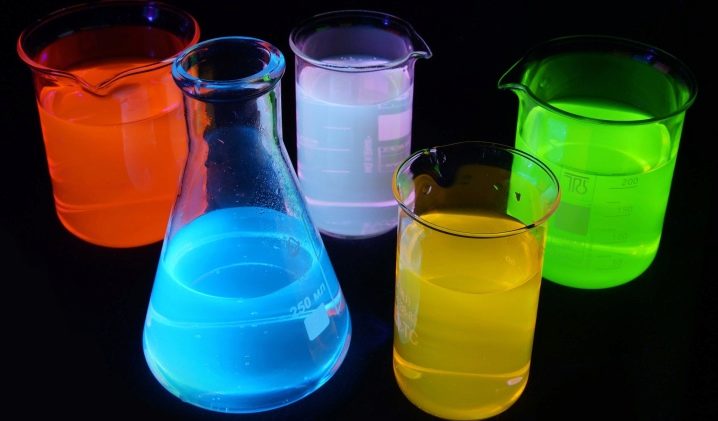
A competent approach to the material and object of decoration will exclude inappropriate use. Too bright light in bedrooms and lounges can be harmful to your health and emotional well-being. When starting a renovation, study the opinions of experienced designers, reviews and photos of clients, create a preliminary layout of the future creation, think over and simulate all the options so that the update brings only positive emotions. Verified suppliers and small quantities of goods are the key to success.

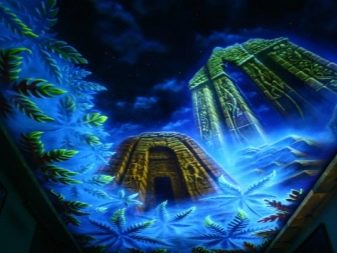
Beautiful interior solutions
Professional artists will help you choose beautiful interior solutions for every corner of your home.
- The shimmering distance of mysterious planets in the bedroom of your beloved baby will create an atmosphere of fairy tale and magic.
- The mesmerizing glow of the moon, the Milky Way will set you up for the atmosphere you need for a romantic evening with your loved one.
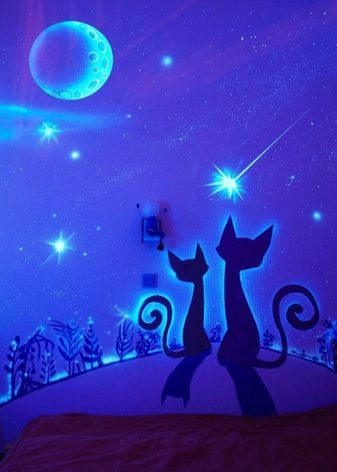
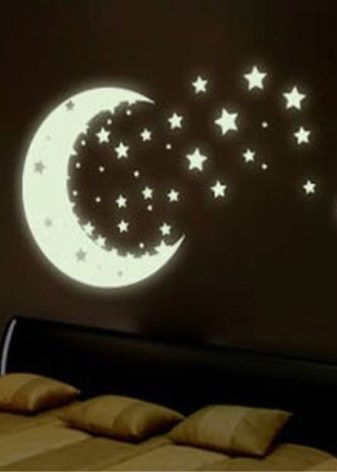
For information on what types of glowing paints are and how to apply them, see the next video.













The comment was sent successfully.